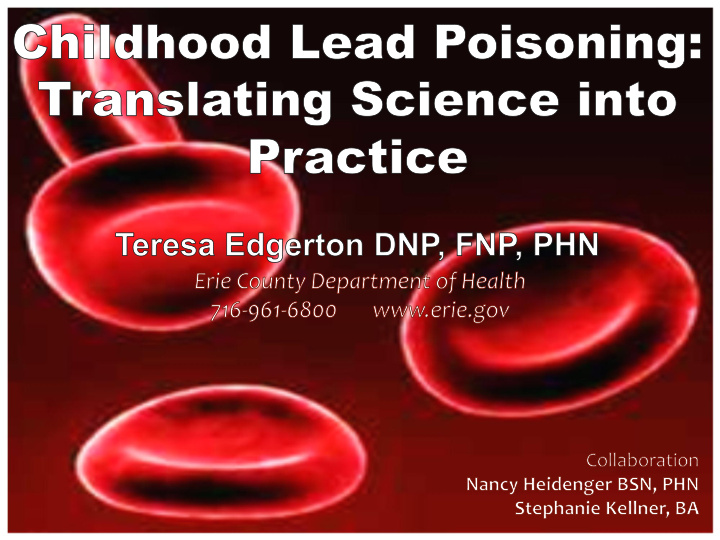



1
Review Lead history, sources, & toxicant Explain New CDC “Reference Value” Examine scope of problem Identify Vulnerable populations & clinical Impact Describe translating science into practice Promote Primary Prevention & collaboration 2
Lead History 3
Natural element Among 1st metal known Beneficial economic uses Non biodegradable U.S. 3rd largest producer Agency for Toxic Substances and Disease Registry [ATSDR], 2013 4
Pre-1978 housing Vintage children’s products Printing ink Plumbing, water pipes Cosmetics & >400 lipsticks United States Environmental Protection Agency [EPA], 2014 5
#1 Environmental threat Toxic to humans Ingested & Inhaled Any Microgram of lead per deciliter of blood(mcg/dL or μ g/dL) 6 Centers for Disease Control and Prevention [CDC], 2015
tons) 7 EPA, 2010
https://www.youtube.com/watch?v=C0HnWFrQlo4 8
CDC criteria based on housing statistics & BLL elevation New ~ Provider & Public Health action levels CDC, 2015 9
Scope of Problem 10
535,000 U.S. children BLL’s >5 mcg/dL ages <6 years Poverty & substandard housing disproportionately lead exposure risk Annual US costs >$50 billion Individual cost $5,600 11 US Census Bureau, 2010
12 EPA,, 2014
Pre-1978 housing >82% 343,879 homes contain lead hazards Highest US child lead poison rate Poverty level 22.5% children ages <5 13 Community Health Assessment, 2014
14 Erie County Dept. of Health [ECDOH]
Vulnerable Population & Clinical Impact 15
Ages <6 yrs. Frequent hand to mouth activity Rapid lead absorption Levels peak between ages 18-36 mos. 16
17
Absorbed Half life Blood (RBC) 25 to 40 days Soft tissue 40 days Mineralizing tissues Up to 30 years 18
Lower academic Central Nervous achievement System Impaired impairment Neurobehavioral Attention deficit development hyperactivity Delayed puberty disorder-ADHD Cognitive deficits Reproductive impairment Hearing loss 19 CDC, 2012, HHS, 2012 & ATSDR, 2007
20 20
Cross maternal fetal blood supply 5 mcg/dL Deleterious to fetal brain, liver & bones Infant premature, low birth weight Impaired milestones 1st year & life-long 21
Adults – lead smelters, welders, recycled batteries, Auto repair, construction & Industrial workers Refuge/Immigrant population – Ayurvedic & traditional medicines, candy, spices & cultural cosmetics 22
23
Translating Science to Practice 24
Translating Science Practice Current NYSDOH practice Insufficient time to risk assessment <6 yrs. implement new science Blood test-reimbursable Cost (non Ins.- ECDOH) Difficult to change Wall posters & guides current practice model Demonstrate adverse Provider resistance to health effect to missed opportunities of past change practices 25
Erie County, NY 10 year (2004 - 2014) childhood blood lead test elevations 5 -9 mcg/dL 10 - 14 mcg/dL 15 -19 mcg/dL 20 -44 mcg/dL >45 mcg/dL 26 ECDOH, 2015
Birthing hospitals-Lead Prevention Info. Universal lead test ages 1 & 2 Assess all children ages 6 mos.- 6yrs during routine well-child & ED visits Provide anticipatory guidance Test all foreign-born up to age 16 yrs. 27
28
Child Safety Protection Act Congress & Federal Laws In 1974 - Safe Drinking Clean & healthy NY Water Act CDC/Public Health Laws 1978 lead-based paint ban Health Care Providers 1996 leaded-gas ban Agency for Toxic Environment Protection Substances & Disease Agency - Regulations Registry Clean Air Act-lead smelters State & LHD & LRC Consumer Product Safety Improvement Act of 2008 US Food & Drug (CPSIA ) Administration HUD Lead Regulations Occupational Safety & National screening Health Admin programs 29
30 CDC, 2015
*R *Reference Healt ealth Car are e Provider vider ECDOH EC WN WNYLR LRC Consult onsultation: ion: Value BLL (mc mcg/dL dL) Repeat BLL in 6-12 No action No action BLL < 5 Consultant mos. if at risk Anticipatory guidance Repeat FS BLL in 3-6 Home No action BLL 5 - 9 mos. inspection Repeat sooner Risk during warm mos . reduction Consider MVI Parent Provide nutritional education Consultation guidance Monitor Development Anticipatory guidance 31
LEAD CARE II In-office capillary testing & Immediate results Cost effective Requires venous confirmatory >8 mcg/dL Report results to NYSIIS or ECLR < 2 wks. 32
BLL (mc mcg/dL dL) Healt ealth Car are e ECDOH EC WNYLR WN LRC Provider vider Consult onsultation: ion: Repeat or Consult Consultation BLL >25 NCM confirm Blood Home lead test - 1 mo inspection Developmental Assessment MVI Risk reduction Health education Anticipatory guidance 33
BLL(mc mcg/dL dL) Heal ealth th Car are e Provide ider EC ECDOH WN WNYLR LRC Consult onsultation: ion: Repeat or confirm Urgent Immediate BLL >45 Blood lead test consult consult NCM CHOB within 48hrs. Blood test-Zinc Urgent admit – Protoporphyrin home AXR, blood (ZPP) or Free inspect. lab. & Erythrocyte Chelation Protoporphyrin therapy (FEP) & CBC Educate-CHOB admit, AXR, & * Chelation therapy Post CHOB D/C freq. BLL’s, MVI & Developmental Eval. 34
Collaboration 35
Provides children lead elevations medical & environmental intervention Child lead program - WNY (716) 961-6800 Erie-Niagara-Chautauqua lead primary grant Continual collaboration - Medical Director of Western New York Lead Resources: Dr. Melinda Cameron, MD (716) 878-7324 36
Laboratories NYSDOH Childhood Lead Poisoning Prevention Program: • Nurse case manager • Health education • Service coordination • Environmental coordination 37
Childhood Lead Poisoning Prevention Program: Action levels >15 mcg/dL Lead Primary Prevention: Action levels 5-14 mcg/dL Nine zip codes : 14201 14207 14208 14209 14210 14211 14212 14213 14215 (Healthy neighborhood – 14206 14206 14218) Lead Hazard Control Program 38
Prolonged low-level lead Chronic damage to potentially every organ NO treatment exist to reverse adverse health NO safe lead threshold Science to Practice Primary Prevention “Public Health Priority” 39
Recommend
More recommend